Resistance Correlation of Different Levels of Battery Swelling
The multiplier performance of the battery affects the speed and life of the battery charge and discharge. How to reduce the internal resistance and improve the multiplier performance of the battery is the direction that the battery researchers are constantly exploring. The internal Resistance of the battery is composed of different components, the structure of the buckle battery, the internal resistance includes positive and negative electrode shell, electrode plate, diaphragm, diaphragm, gasket / shrapnel, and the parts of the preparation process of the whole buckle battery component resistance, different levels will affect the final battery resistance, can control the battery design and production process, improve the multiplier performance of the battery.
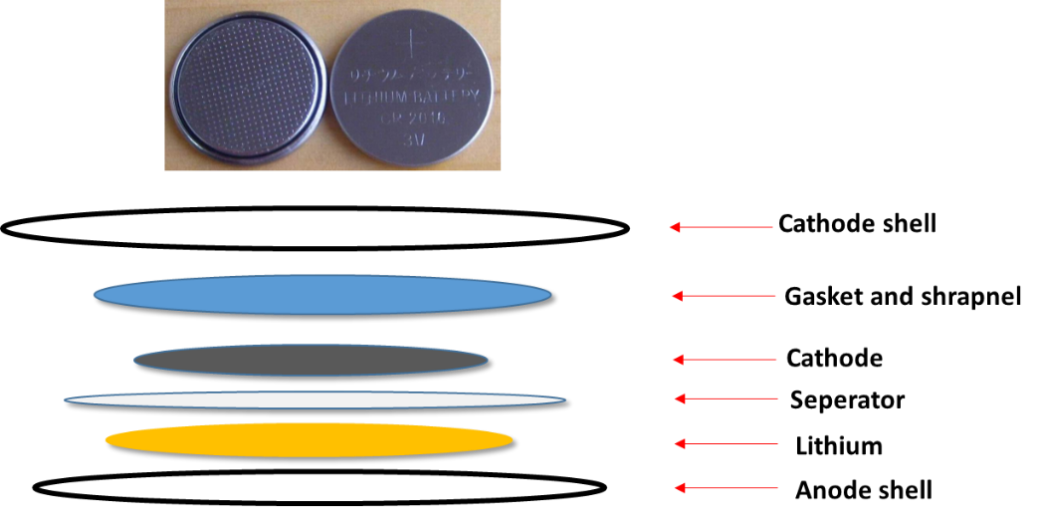
Figure 1.Schematic diagram of the buckle battery structure
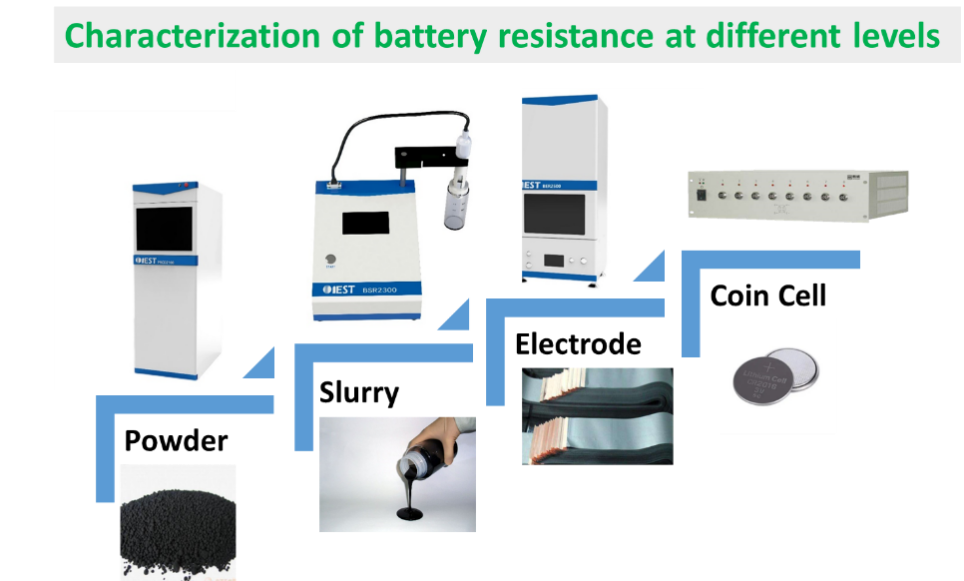
Figure 2.Test methods of different levels of the battery
1.Experimental Protocol & Test Conditions
1.1 Experimental Scheme: 5 ternary powder with different resistivity are selected, according to the mass ratio of 96.5:1.5:2 (active substance: conductive carbon: PVDF) for slurry production with 53.3% fixation and followed the conventional procedures of coating, roller pressing, punching, buckle assembly and testing.
1.2 Test Conditions
1.2.1 Powder Resistivity: 5~200MPa, with an interval of 50MPa, and a pressure holding rate of 10s.
1.2.2 Pulp Resistivity: continuous test for 5min, with 20s mining point interval.
1.2.3 Pole Sheet resistivity: 5MPa, with pressure holding for 15s.
1.2.4 Stop D CR:25℃,20%DOD,1.5C discharge for 30s.
2.Resistivity Analysis of Different Levels of the Battery
2.1 Powder resistivity
Five ternary materials with different resistivity are selected as the positive electrode of the buckle battery. From Figure3(a), as the applied pressure increases,the compaction density of the five samples is between 2 and 3g/cm3, and the compaction density is 3g/cm3, corresponding to the resistivity of 200MPa, as shown in Figure 3(b), resistivity is 1 # <2 # <3 # <4 # <5 #.
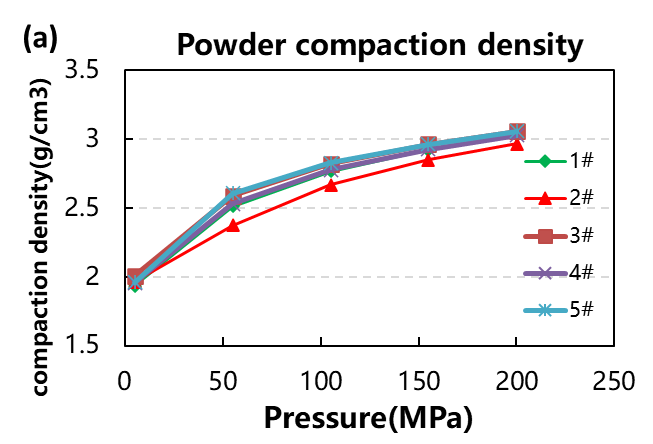 |
 |
Figure 3.(a) compaction density curve of 5 powders; (b) resistivity comparison of 5 powders
2.2 Morp Resistivity
After the 5 samples are stirred in the same formula, the resistivity test is conducted with the slurry resistor, and the resistivity value after about 3min is relatively stable, compared with the same period last year. At this time, it can be found from Figure 4 that the resistivity size of the 5 kinds of slurry is: 1 # <5 # <3 # <2 # <4 #, similar to the change of M type, compared with the powder state, 3 # and 5 # slurry is lower, which is likely related to the slurry type of 1.5% more conductive carbon, because the conductive carbon conductivity is much greater than ternary materials, and its dispersion degree and state in the slurry will affect the measurement of paste resistivity.
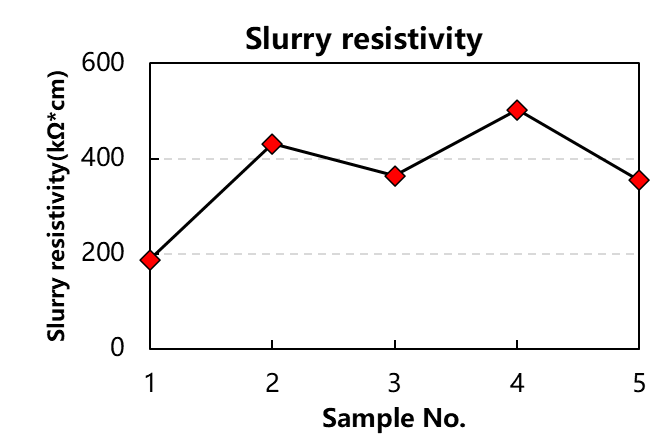
Figure 4. Comparison of the resistivity of the five pulps
2.3 Pole Plate Resistivity
The resistivity test of the same conditions before and after the roller pressure, as shown in Figure 5, the compaction density is increased to 3 g/cm3, consistent with the state of the powder compaction, and the resistivity is much lower compared with the roller pressure, mainly due to the active particles, the active particles and the conductive carbon, the contact between the coating layer and the fluid collector. Year resistivity trend, similar to the paste resistivity M type change, this shows that when the formula is consistent, the paste and pole resistivity trend is closer, but the two particle contact state is different, and the slurry contains a lot of solvent affect electron transmission, so paste resistivity (kΩ*cm) absolute value is significantly greater than the polar resistivity (*cm).
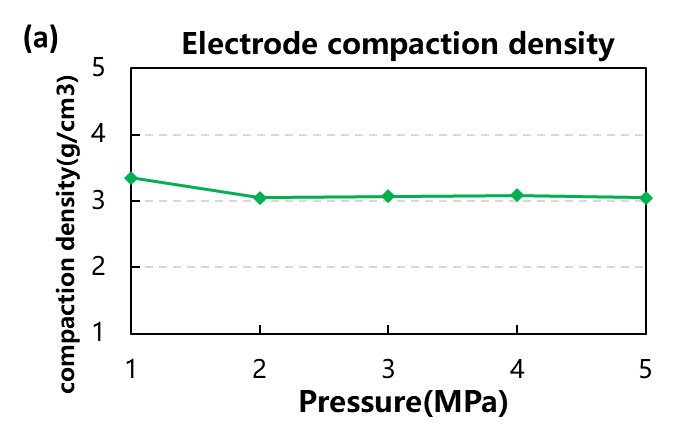 |
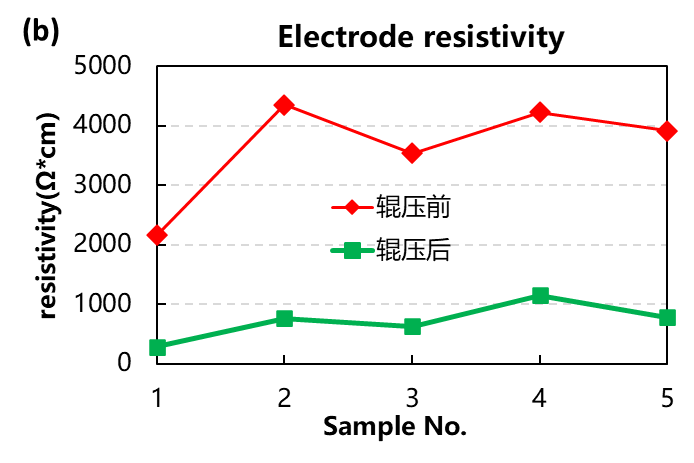 |
Figure 5.(a) compaction density of five poles,;Figure 5 (b) resistivity comparison of five poles
2.4 Internal Resistance (DCR)
The assembled buckle static is set for 12h. After two laps of charge and discharge activation, it is tested according to the DCR process shown in Figure 6(a). When calculating DCR, the voltage difference before and after discharge is divided by the discharge current. From Figure 6(b), the DCR of the first three samples was significantly less than 4# and 5#, and is different from slurry and powder resistance trends, while the internal resistance trends of 4# and 5# are consistent with slurry and pole sheet resistance trends. The buckle internal resistance measured by the condition of discharge 30s contains the electronic resistance of each component, including the charge transfer resistance and lithium-ion diffusion resistance, so there are more influencing factors, and it is likely to be inconsistent with the resistance trend of powder, slurry and pole sheet.

Figure 6.(a) DCR test process; Figure6 (b) DCR comparison of five types
3.Summary
This paper for different levels of powder, slurry, pole and buckle battery resistance test, analysis of the correlation between resistance, we found that the slurry resistivity and pole resistivity trend is similar, but because the slurry is suspension state, the resistivity is the order of magnitude of thousand ohm/cm, and pole because is sheet film, resistance is ohm/cm, the absolute value of the resistivity is nearly 1000 times. From the powder level to the slurry level, if the resistivity difference of the powder state is small, the resistivity trend is likely to be inconsistent with the powder state due to the addition of other excipients and solvents in preparing the slurry, coupled with the volatility of the preparation process. Further extended to the DC internal resistance of the buckle, because it contains the electronic resistance of each buckle component, but also includes the charge transfer resistance and lithium-ion diffusion resistance, affecting many factors, and powder, slurry, pole plate resistance trend is likely to not be consistent.
Therefore, from the powder, slurry, pole, buckle these four different levels of resistance correlation, is likely to get inconsistent trend, but because each level of the resistivity parameters can represent the stability and trend of the level samples, so monitoring each level of resistivity parameters is helpful to help research and production personnel better screening electrical performance of excellent materials and monitor the stability of the material and cell production process.
Reference Documentation
1.Xu Jieru, Li Hong, et al., lithium battery research. Energy Storage Science and Technology, 2018,7 (5) 926-955.
2.Hiroki Kondo et al.Influence of the Active Material on the Electronic Conductivity of the Positive Electrode in Lithium-Ion Batteries .Journal of The Electrochemical Society, 2019,166 (8) A1285-A1290.
3.Nie Lei, Qin Xing, Zhang Na, et al. Research on the resistance pre-evaluation method of lithium-ion battery, Power Supply Technology, 2019,43 (4): 562-563.
